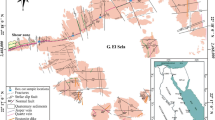Abstract
The effect of hydrodynamic factors such as particle size, irrigation rate and aeration rate on the dissolution of uranium by Acidithibacillus ferrooxidans in column reactor was studied. Response surface methodology (RSM) was applied to predict the behavior of effective parameters and their interactions on the bioleaching process. Under the optimum conditions particle size of 5 mm, irrigation rate of 0.34 L/m2/min and aeration rate of 210 L/m2/min, the maximum value of uranium recovery was 63.85% for 19 days. The results from the statistical model and the experimental data showed good agreement and the most effective factor was the aeration rate. The interaction between particle size and irrigation rate has a negative effect and two other interactions have a positive effect on uranium recovery. Analysis of bioleaching residue confirmed the formation of K-jarosite on the surface of particles. The modified kinetic model at optimum conditions showed that cathodic ferric reduction is the rate controlling step on uranium bioleaching recovery.
Similar content being viewed by others
References
Gilligan, R. and Nikoloski, A.N, The extraction of uranium from brannerite—A literature review, Miner. Eng., 2015, vol. 71, pp. 34–48.
Petersen, J, Determination of oxygen gas-liquid mass transfer rates in heap bioleach reactors, Miner. Eng., 2010, vol. 23, pp. 504–510.
Pradhan, N., Nathsarma, K.C., Srinivasa, R.K., Sukla, L.B., and Mishra, B.K, Heap bioleaching of chalcopyrite: A review, Miner. Eng., 2008, vol. 21, pp. 355–365.
Ojumu, T.V., Petersen, J., and Hansford, G.S, The effect of dissolved cations on microbial ferrous-iron oxidation by Leptospirillum ferriphilum in continuous culture, Hydrometallurgy, 2008, vol. 94, pp. 69–76.
Guay, R., Silver, M., and Torma, A.E, Ferrous iron oxidation and uranium extraction by Thiobacillus ferrooxidans, Biotechnol. Bioeng., 1977, vol. XIX, pp. 727–740.
Junior, O.G, Bacterial leaching of uranium ore from Figueira-PR, Brazil, at laboratory and pilot scale, FEMS Microbiol. Rev., 1993, vol. 11, pp. 237–242.
Munoz, J.A., Blasquez, M.L., Ballester, A., and Gonzalez, F.A, Study of the bioleaching of a Spanish uranium ore, part III: Column experiments, Hydrometallurgy, 1995, vol. 38, pp. 79–97.
Qiu, G.Z., Li, Q., Yu, R., Sun, Zh., Liu, Y., Che, M., Yin, H., Yage, Zh., Yili, L., Xu, L., Sun, L., and Liu, X, Column bioleaching of uranium embedded in granite porphyry by a mesophilic acidophilus consortium, Bioresour. Technol., 2011, vol. 102, pp. 4697–4702.
Mehtal, K.D., Kumar, V., Pandey, B.D., and Tamrakar, P.K, Column bioleaching of a low grade silicate ore of uranium, Miner. Process. Extractive Metall. Rev., 2010, vol. 31, pp. 224–235.
Karamanev, D.G., Nikolov, L.N., and Mamatarkova, V, Rapid simultaneous quantitative determination of ferric and ferrous ions in drainage waters and similar solutions, Miner. Eng., 2002, vol. 15, no. 5, pp. 341–346.
Bouffard, S.C., Understanding the heap biooxidation of sulfidic refractory gold ores, PhD Dissertation, University of British Columbia, 2003.
Finkelestein, N.P., Needed, C.R.S., and Nicol, M.J, An electrochemical model for the leaching of uranium dioxide, National Institute for Metallurgy, 1972.
Burkin, A.R., Chemical Hydrometallurgy, Theory and Principles, Imperial College Press, 2001.
Dixon, D.G. and Hendrix, J.L, A mathematical model for heap leaching of one ore more solid reactants from porous ore pellets, Metall. Mater. Trans. B, 1993, vol. 24, no. 6, pp. 1087–1102.
Lizama, H.L., Harlamovs, J.R., McKay, D.J., and Dai, Z, Heap leaching kinetics are proportional to the irrigation rate divided by heap height, Miner. Eng., 2005, vol. 18, pp. 623–630.
Yin, S., Wu, A., Hu, K., Wang, Y., and Zhenlin, X, Visualization of flow behavior during bioleaching of waste rock dumps under saturated and unsaturated conditions, Hydrometallurgy, 2013, vol. 133, pp. 1–6.
Choi, M.S., Cho, K.S., Kim, D.S., and Ryu, H.W, Bioleaching of uranium from low grade black schists by Acidithiobacillus ferrooxidans, World J. Microb. Biot., 2005, vol. 21, pp. 377–380.
Molson, J.W., Fala, O., Aubertin, M., and Bussiere, B, Numerical simulations of pyrite oxidation and acid mine drainage in unsaturated waste rock piles, J. Contam. Hydrol., 2005, vol. 78, pp. 343–371.
Tao, H. and Dongwei, L, Presentation on mechanisms and applications of chalcopyrite and pyrite bioleaching an biohydrometallurgy—A presentation, Biotechnol. Reports, 2014, vol. 4, pp. 107–119.
Gramp, J.P., Jones, F.S., Bigham, J.M., and Tuovinen, O.H, Monovalent cation concentrations determine the types of Fe(III) hydroxysulphate precipitates formed in bioleach solutions, Hydrometallurgy, 2008, vol. 94, pp. 29–33.
Nurmi, P., Özkaya, B., Sasaki, K., Kaksonen, A.H., Tuovinen, O.H., Riekkola-Vanhanen, M.L., and Puhakka, J.A, Biooxidation and precipitation for iron and sulfate removal from heap bioleaching effluent streams, Hydrometallurgy, 2010, vol. 101, pp. 7–14.
Author information
Authors and Affiliations
Corresponding author
Additional information
The article is published in the original.
About this article
Cite this article
Zare Tavakoli, H., Abdollahy, M., Ahmadi, S.J. et al. The effect of particle size, irrigation rate and aeration rate on column bioleaching of uranium ore. Russ. J. Non-ferrous Metals 58, 188–199 (2017). https://doi.org/10.3103/S106782121703018X
Received:
Published:
Issue Date:
DOI: https://doi.org/10.3103/S106782121703018X




